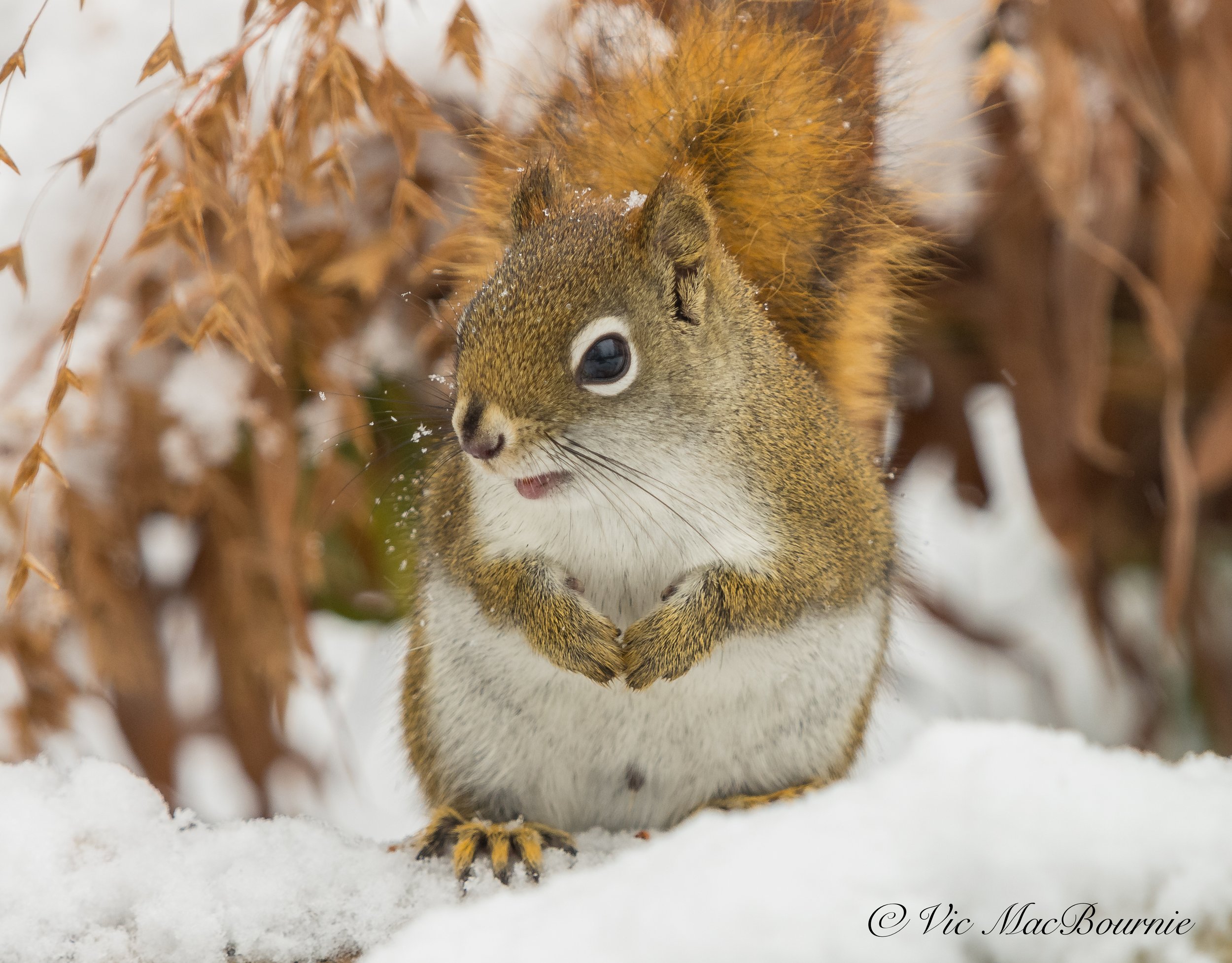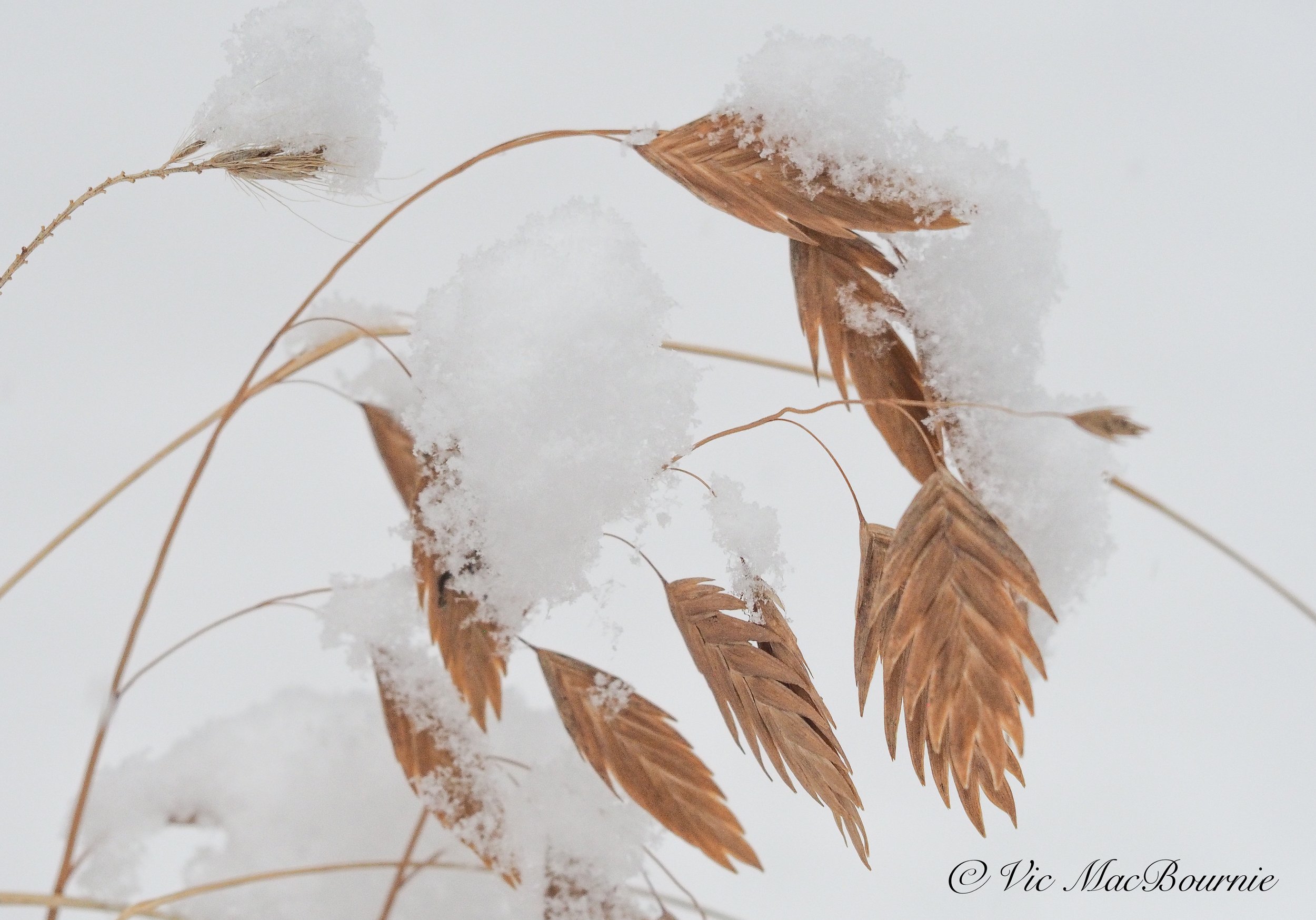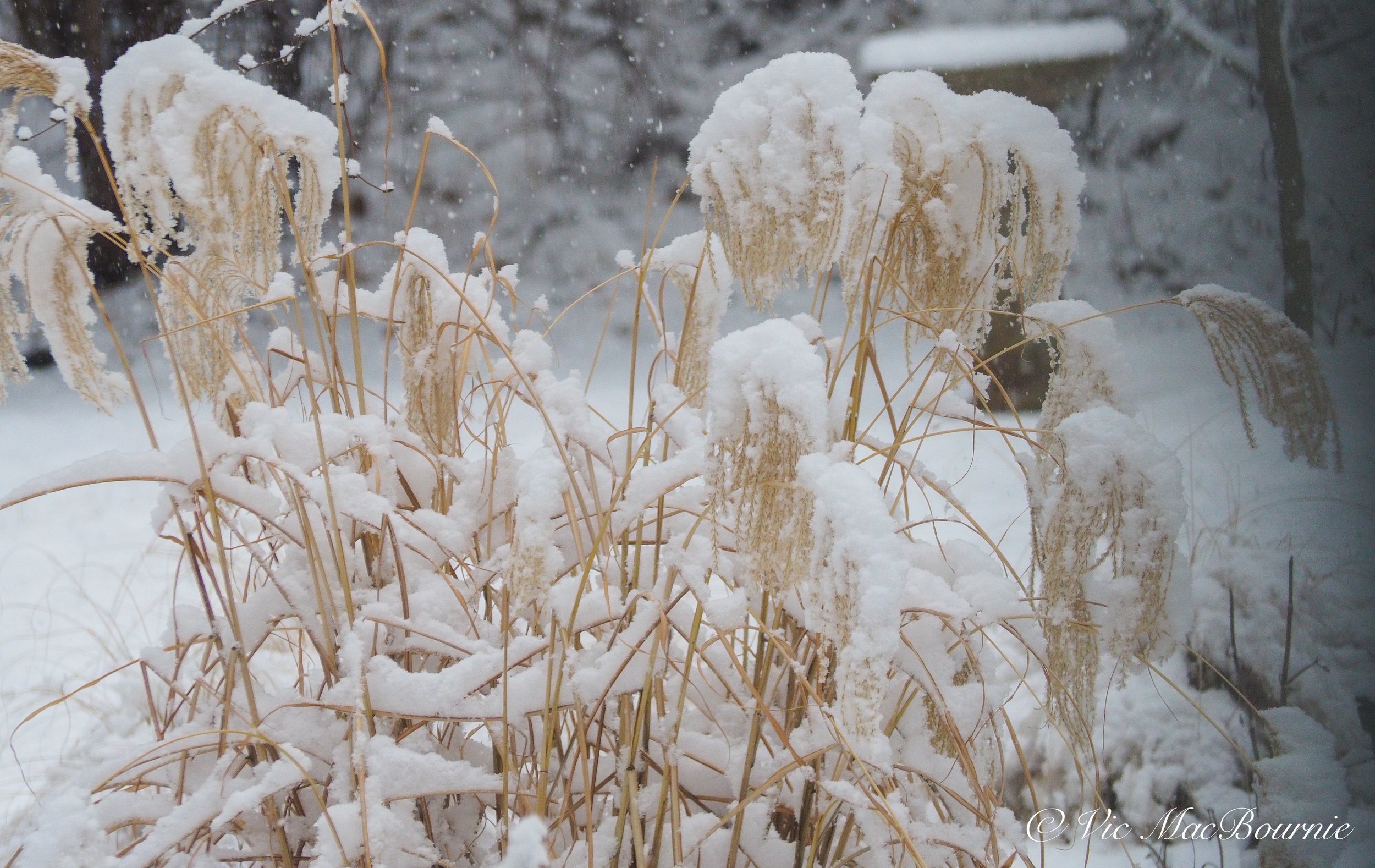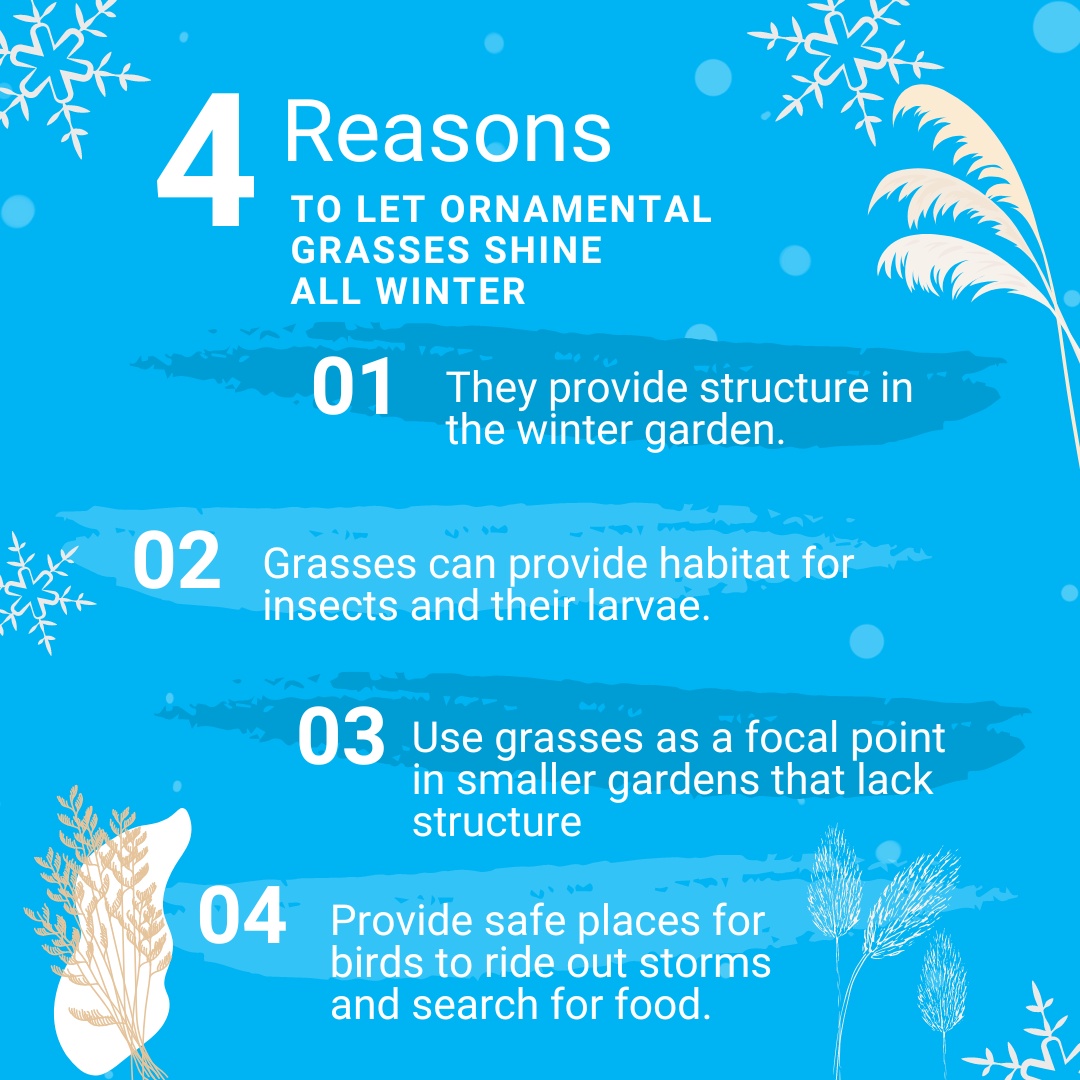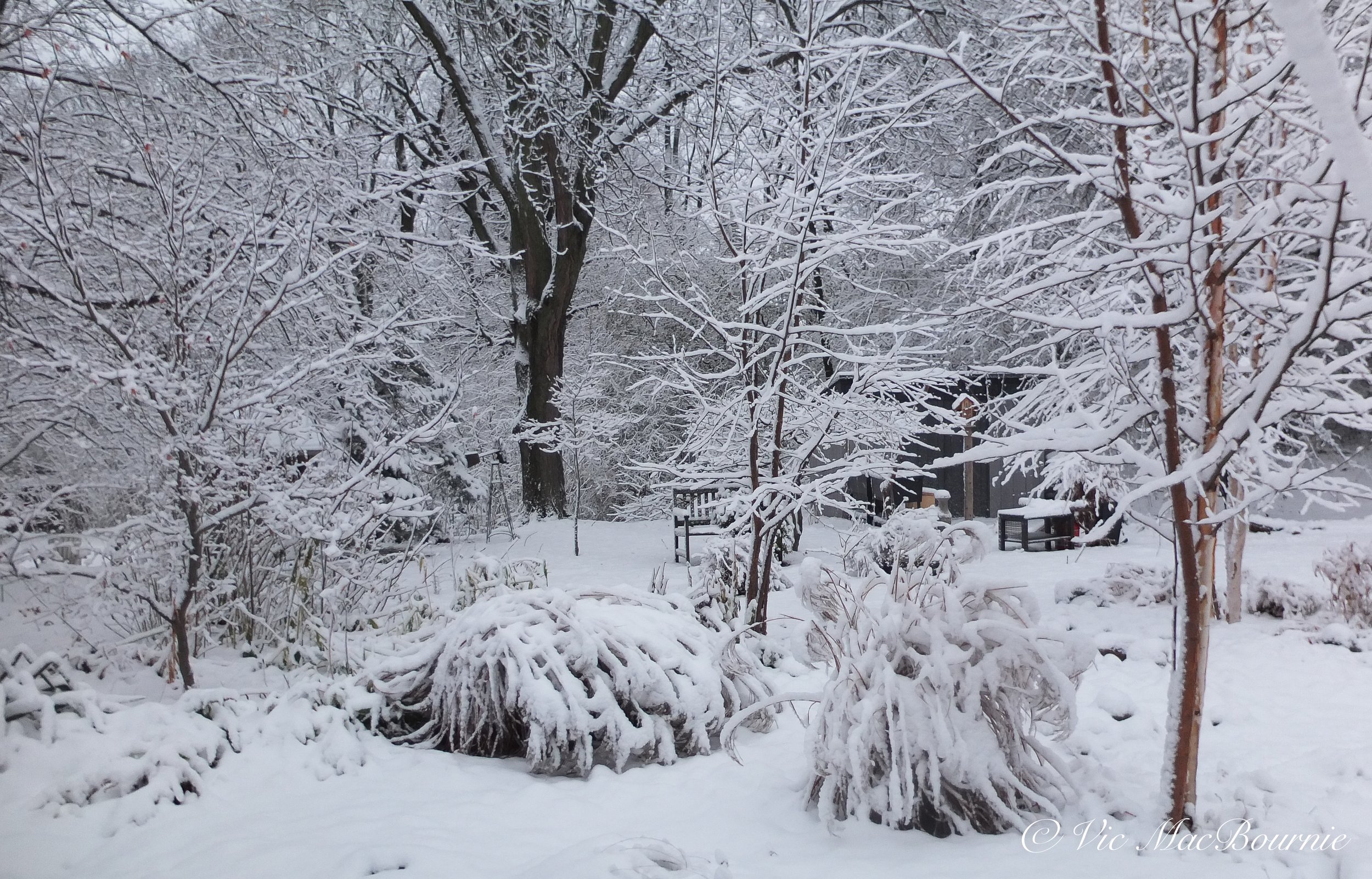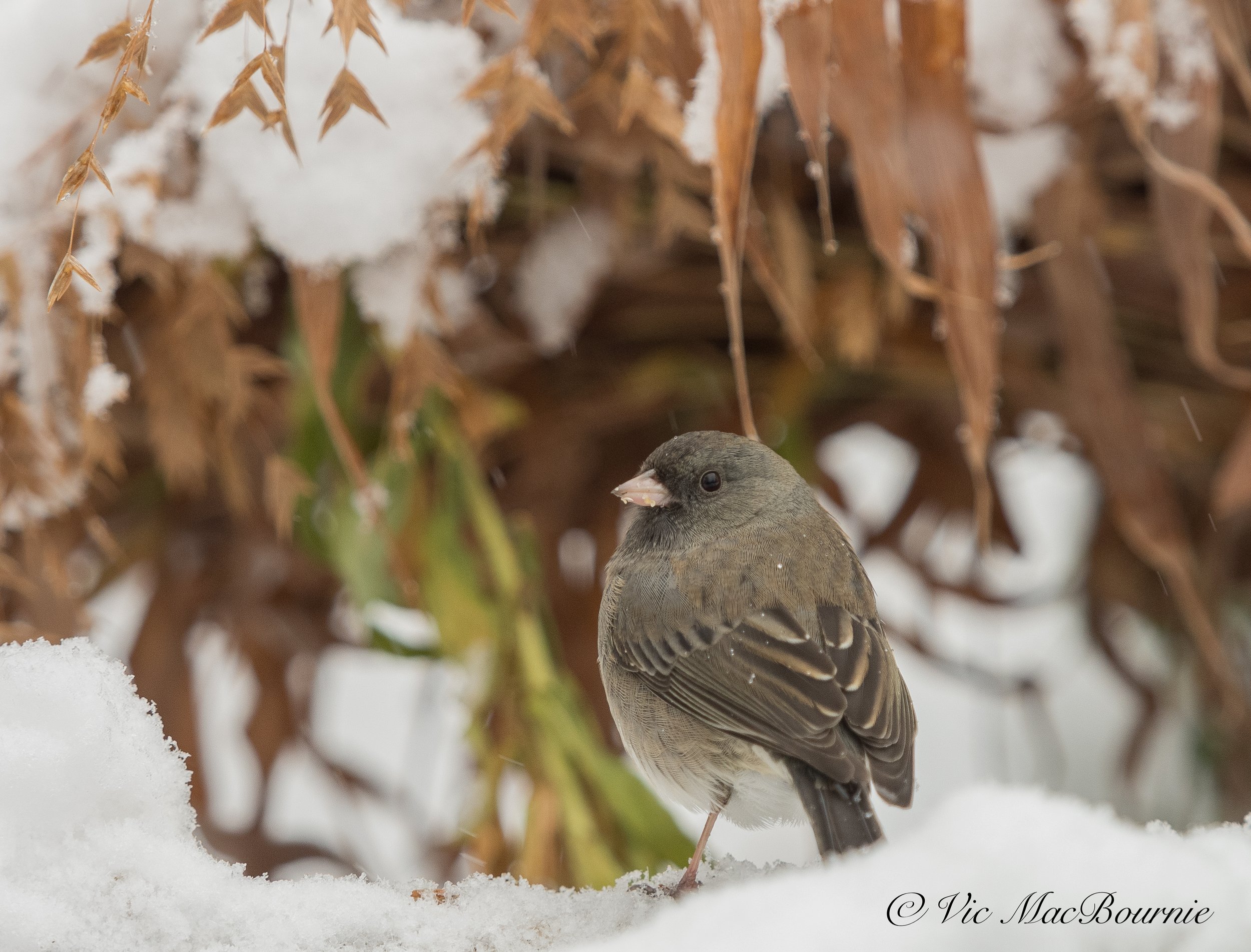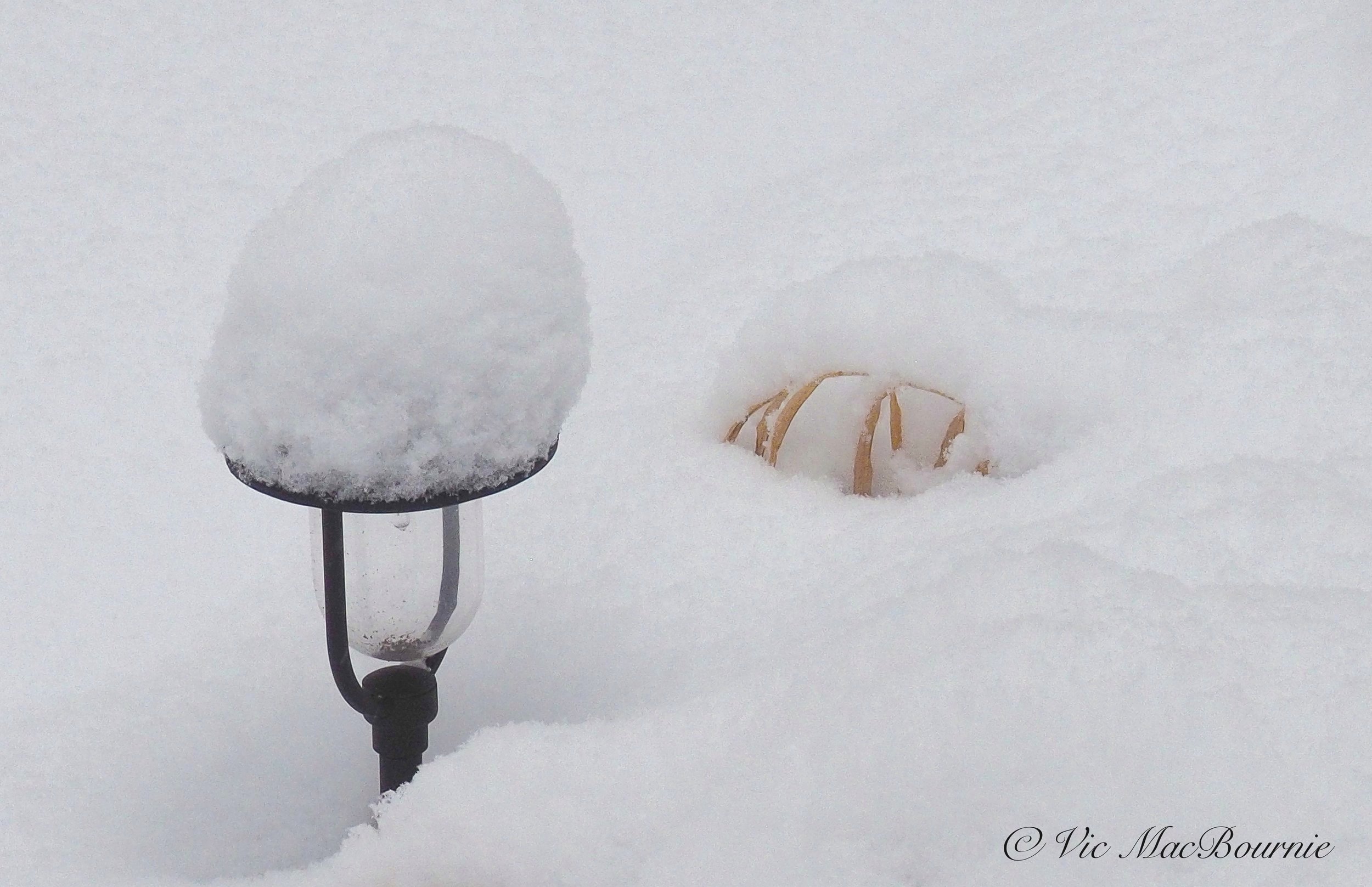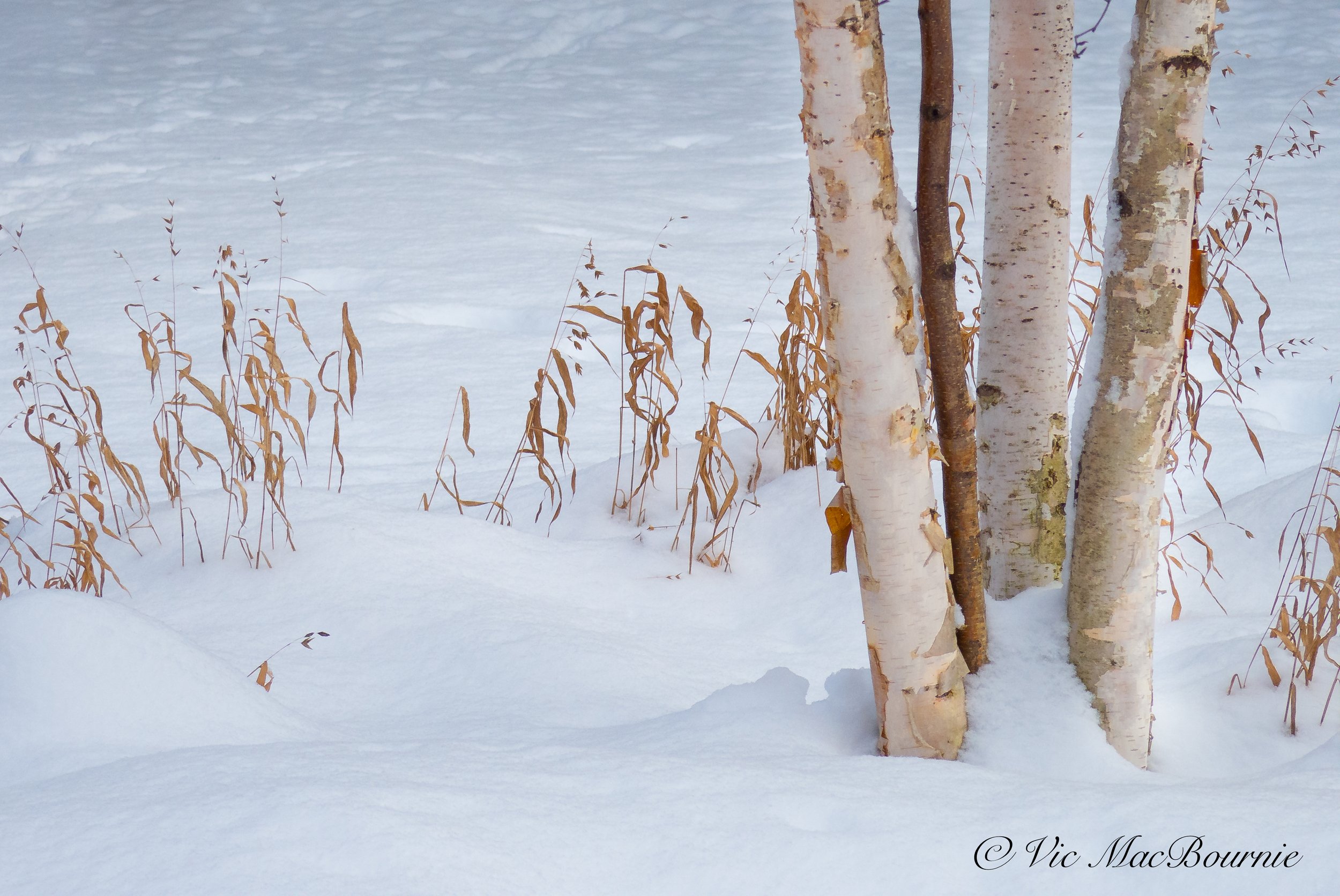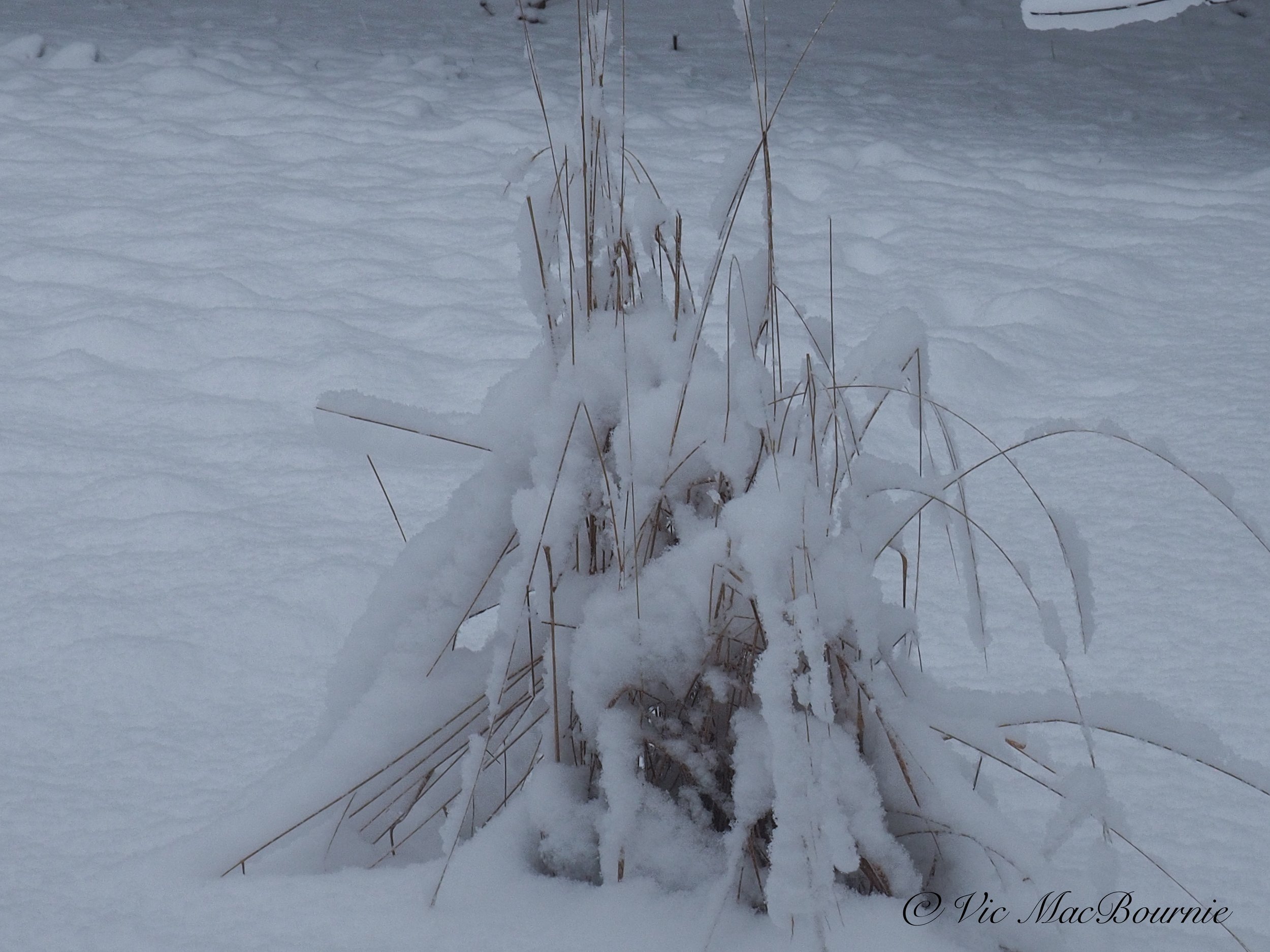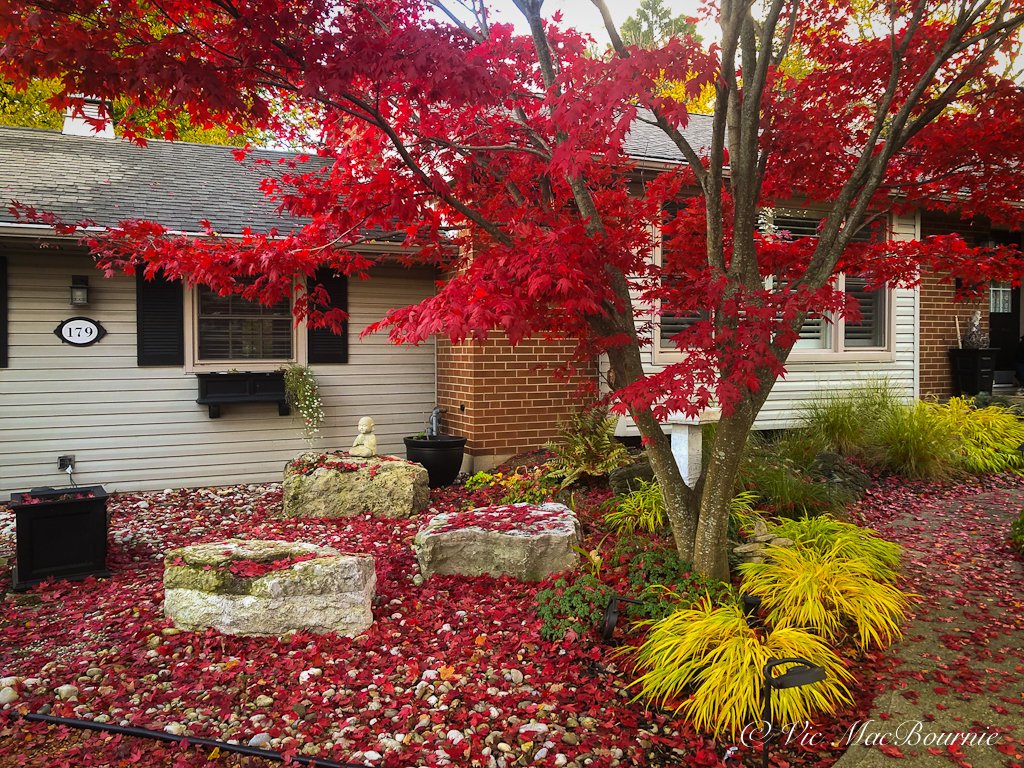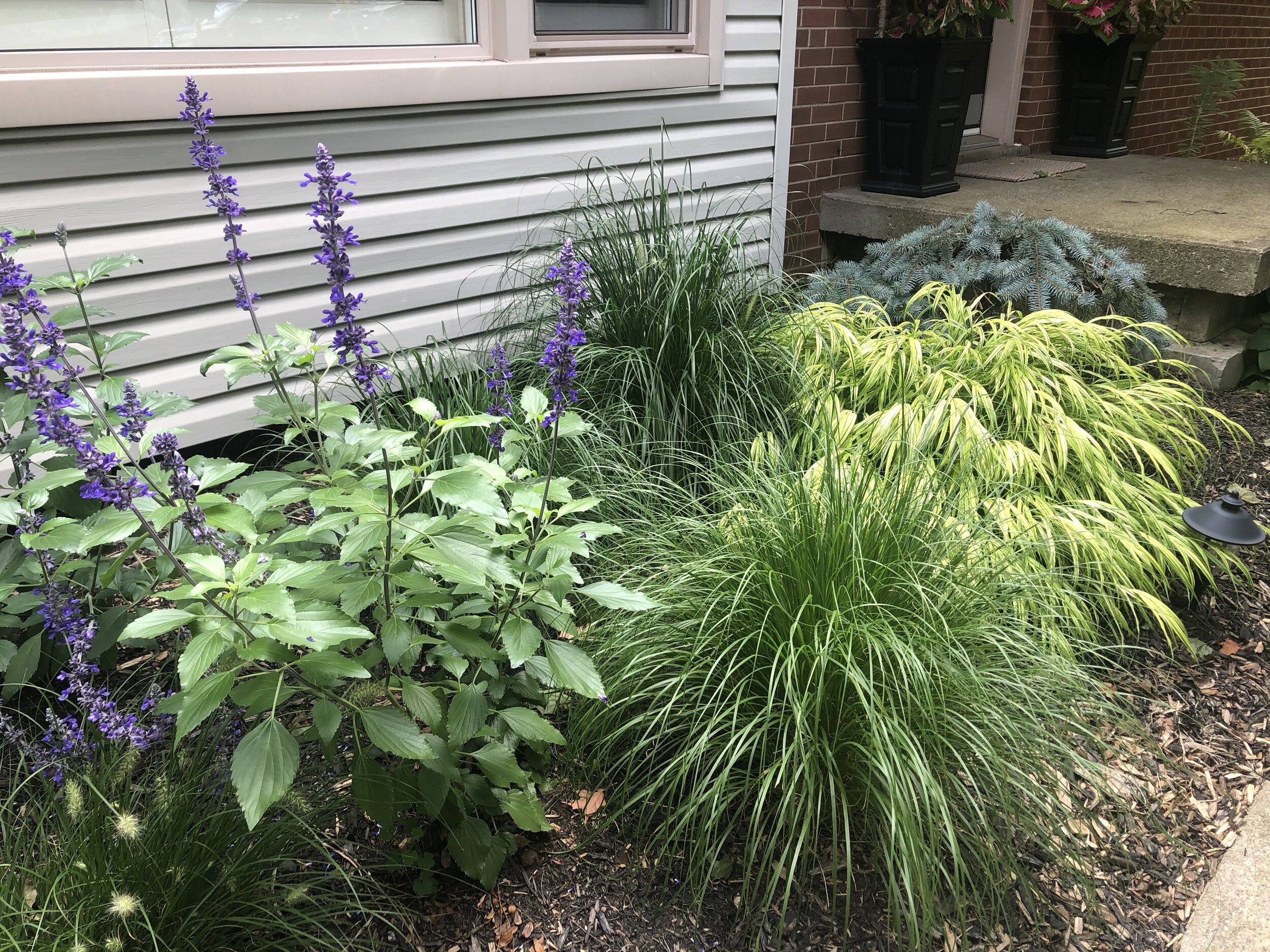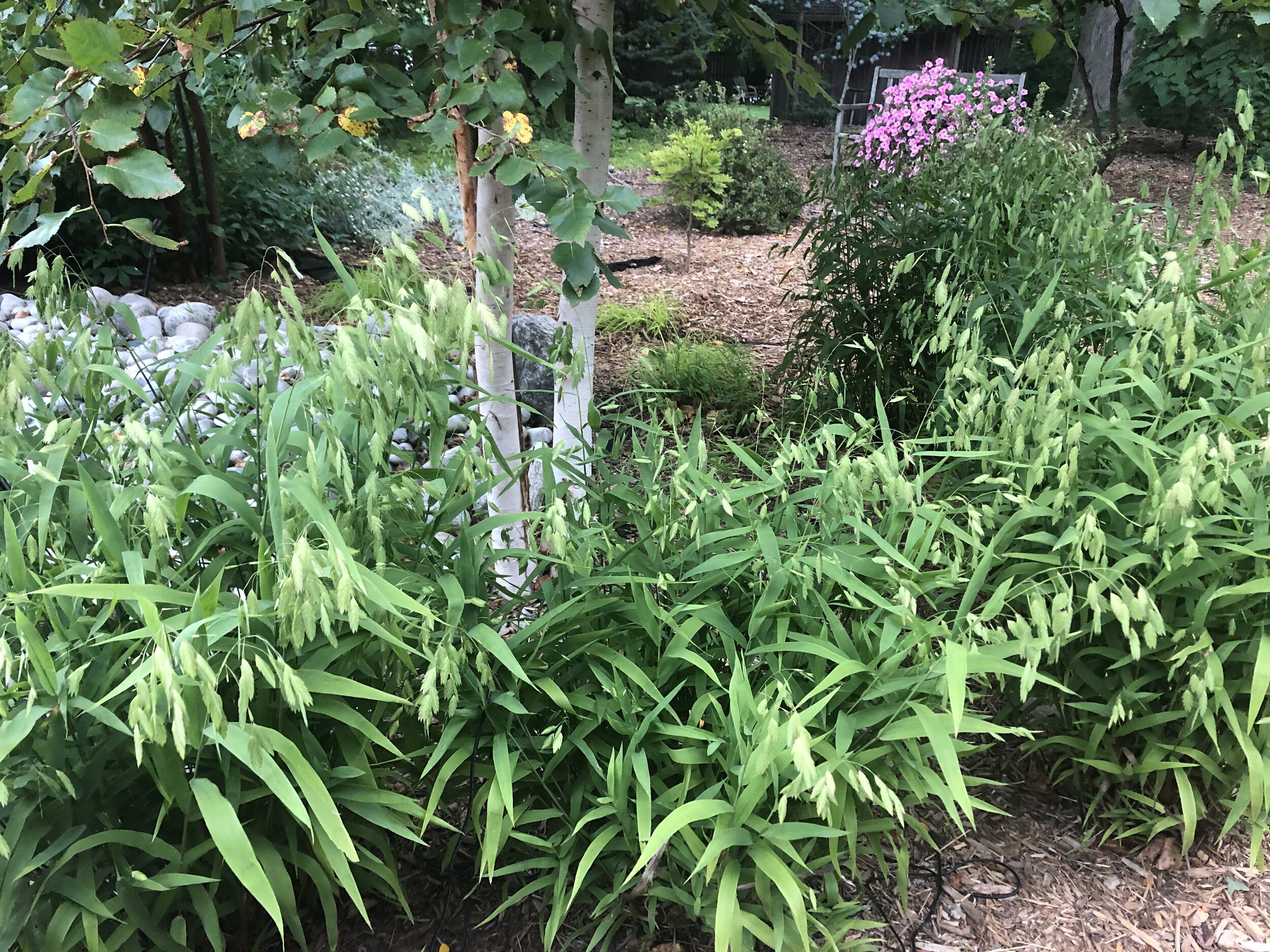Why leave ornamental grasses standing through winter?
Ornamental grasses have become popular additions to our gardens for summer and fall interest, but they really come into their own in winter where they add structure and even movement in the winter garden.
Grasses provide structure and habitat for the garden in winter
There are two reasons I leave our grasses standing all winter. First, wildlife – from insects to birds – benefit from the standing grasses and second, I just love the look of the wheat-coloured grasses providing structure in the garden from the fall through to the following spring.
There is another important reason to leave the grasses standing, but we’ll get to that in a minute.
During the winter months, when snow is covering the ground, our grasses provide amazing structure to the garden and are often the first element I focus on when looking for photographic subjects. The results can range from high-key images of the delicate wisps of wheat-coloured grasses against a pure white background, to an image of a bird tucked away in the grasses waiting out a heavy snowfall.
In the early part of winter, capturing the seed heads poking out from the snow is a favourite subject, however, as winter draws on, the seeds heads are either eaten by the birds or dispersed from the cold winds.
Be sure to take advantage of the early part of winter to catch images of the seed heads in the snow.
It’s also a good time to capture the spent flower heads from the Black Eyed Susans with snow caps on before the goldfinches strip the seeds from the flower heads.
Are ornamental grasses perennial?
You may ask if ornamental grasses are annual or perennial? The answer is, of course, it depends. But it’s safe to say that most ornamental grasses you purchase are hardy perennials and will return year after year. Most ornamental grasses are very hardy but a few, including the large red- or purple-coloured fountain grass (Pennisetum setaceum) that is popular to use in containers, is a fast-growing – up to 4-feet – annual in most areas. It is actually hardy in tropical zone 9.
Because most ornamental grasses are perennial, they will require cutting down when they have expired. There is no problem leaving perennial or annual grasses up through the winter. Both will provide structure and beauty throughout the cold months.
Annual grasses, including the annual purple fountain grass, can simply be removed and discarded in the spring along with the cuttings of the perennial grasses.
I like to pile them on top of a natural compost heap to give the birds an opportunity to take the grass to build their nests. I also stuff handfulls of the dried grass in the suet holders in spring for the birds to take as nesting material.
More on Ornamental grasses:
Grasses help form the structure of a winter garden
Ornamental grasses might be the last thing you think of when looking for winter structure and interest in the garden. Typically, we look to evergreens to form the basic structure of a winter’s garden. Not everyone, however, has room to plant large evergreens such as spruce, pines or cedars.
That’s when ornamental grasses rise to the challenge.
Small enough to suit even the most compact gardens, these grasses can provide four-season interest with winter, arguably, being the time they shine the most. In many gardens, they are the only non-woody plant still standing, and their tan colour helps them stand out against a snowy or just drab winter background.
They can also add movement when the winds of winter blow, and their vase-like structure adds another dimension to our garden.
A third reason to leave your ornamental grasses
There is another very important reason to leave grasses standing throughout the winter, and that is to protect the roots of the grasses from extreme temperatures, especially the constant freezing and thawing that is common over the course of our winters.
If you are like me and fall garden clean up amounts to putting away the hummingbird feeders, patio umbrellas and garden chairs, then you’ll benefit from a buildup of leaves around the plants which will form a nice layer of insulation around the roots of the grasses. The grasses will often fold in on themselves as well, providing additional “winter mulch” for the plants, wildlife and insects that count on the grasses for protection and habitat.
This insulation layer will help keep the roots from experiencing the freeze-thaw cycles that can uproot some plants, especially if they are newly planted and the roots have not yet set in completely. Or, if you recently planted a clump after dividing a larger clump of your ornamental grasses in the fall.
This is also the area around the roots where insects will burrow in to survive the winter or lay eggs for next spring.
It’s not uncommon to see Juncos and other insect-eating birds foraging around the leaves at the roots of our grasses looking for insects and larvae.
Ornamental grasses can be a haven for birds in winter
The larger grasses that form sturdy upright branches can provide protection for birds in winter. I have seen birds go into the thick grasses during winter storms to escape the high winds and extreme cold. Some of the grasses get bent over and form a perfect perch for the birds.
Ornamental grasses would not be the first places the birds choose to ride out a winter storm, but if large evergreen trees are scarce in your neighbourhood, tall grasses would probably provide the next best natural shelter.
Best Ornamental grasses for winter interest
Some grasses are definitely better than others for winter interest. Some of the smaller grasses are covered early by snow and others are not vigorous enough to stand up to the harshness of our winters.
Look for native grasses whenever possible to provide the most benefits for wildlife and ensure you are not contributing to invasive non-native grasses spreading into natural areas.
The miscanthus grasses are particularly good for winter interest. They stand over six feet tall in summer with their feathery upright and very attractive pinkish seed heads. In winter, ours usually get knocked down to about four-feet high, allowing them to still stand above even the highest snow accumulations.
The stems turn a lovely beige-tan colour with the beautiful plumes lasting well into winter.
I also find our smaller fountain grasses to be excellent in the first half of the winter before the snow gets too high and buries the plants. But even a tiny bit of the grasses peaking up through the snow can result in a lovely, delicate photographic image. If you are searching for images, look for a single grass blade or grouping of three delicate beige grass blades forming an arc in the snow. If the seed head still remains, it’s a pure bonus.
The hybrid fountain grass Karly Rose is a larger fountain grass that carries lovely pink seed heads in late summer and can withstand more snow in winter before it is buried.
Panicum grasses are also a strong performer with great winter interest.
Calamagrotis Karl Foerster, a popular grass used in both commercial and residential landscaping is another grass that works well in the winter landscape. It’s upright habit and dense growth keeps it performing well into winter even in areas with high snowfall.
Photographing grasses in winter
Grasses, either covered in snow or mostly buried in winter’s ground cover, can be a rewarding photographic experience. But it’s usually not as simple as grabbing your camera and snapping a picture.
Successfully capturing the beauty of grasses in winter involves a number of factors that need to be considered.
The key to success is recognizing the amount of snow in the image. If you are photographing wisps of delicate grasses against a background of snow, it’s important to maintain the delicate look of the image. This would be an example of a high key image where the photograph has a clean white background with just a delicate hint of colour.
To create this image we want to “open up” our lens to allow more light into the scene.
What does this mean and how do you do it?
Shooting a snowy (or white sand beech) scene will trick the camera into thinking there is an incredible amount of light available. As a result, the camera will reduce the amount of light hitting the sensor (film) and give you snow that is very blue or, in the case of black and white photography, very grey. We’ve all seen the Instagram images of a lovely snow scene where the snow is blue and the real subject is too dark.
This is just the result of the camera doing what it does and using the metering system to create a “middle grey” image of the scene.
To compensate for this situation, and ensure the snow stays white, photographers say we have to “open up.” What they mean is we have to add back the light the camera wants to take away from the scene.
Today’s modern cameras are very good at recognizing various lighting conditions, but an abundance of snow is too much for most camera meters.
Below is an example of a typical underexposed snow scene. Compare it to the image below with the proper exposure.
An example of an underexposed snow scene where the snow turns grey or blue as opposed to holding its clean white look.
The same image shows a properly exposed scene where the white snow maintains its proper colour.
Escaping the blues: Simple solutions to photographing in the snow
The solutions to getting white snow are simple.
• If you are shooting in a program mode, (SP, AP or P mode) where the camera is automatically determining the proper exposure, try using the +1, +2 or even +3 compensation override to add the light back to the subject and make the snow white.
Be careful not to add too much compensation or you will (blow out) or take away the detail and texture in the snow. (If you are shooting a snow scene with a lot of blue sky, it’s unlikely any compensation would be necessary.)
• Possibly the easiest way to get the proper exposure is to go to the camera’s programmed shooting modes and look for the snow or sand/beach modes. Use these modes to photograph the snowy landscape. These modes automatically account for the brightness and make adjustments to keep the snow white. You may, however, have to use the camera’s compensation function (maybe +1) to tweak the scene depending how much snow is in the image.
In addition to the snow/sand modes, many of today’s compact cameras also include an “art mode” that allows the photographer to experiment with more artsy images. Set the camera to “high key” to create a delicate, ethereal look that might suit your image perfectly. This would work in a situation where you are moving in close on just a few strands of grass with a pure white background.
• Finally, if you are shooting in manual mode, get the camera’s suggested exposure and then use the +1, +2,+3 compensation to find an exposure that looks right. You can just check the back of the camera to get a feel for how the final image will look.
Bracket your snow scenes for best results
Getting properly exposed images in winter can be tricky, so it is probably a good idea to use bracketing whenever possible.
Bracketing is a process where you tell the camera to shoot a series of images at different settings – most often three images – where one image follows the camera’s suggested meter reading, another is a stop over and the final is a stop under. The result are three images where you have the opportunity to pick the one that works best for you.
I would suggest setting up the bracketing function before going outside so that you don’t have to fiddle with it in the cold.
Of course, some of these adjustments can be made in Lightroom or photoshop after you have taken the images, but it’s best to get it right in camera.
With a few simple adjustments to your approach, there is no reason to put the camera away during winter. Your garden takes on a completely different look in winter and its an opportunity to capture the delicate beauty of winter.
It’s also an opportunity to see the potential weaknesses in your garden’s structure. A picture never lies. Use your winter images to improve the garden structure come spring.
It’s just another good reason to buy more plants.
Use a camera with a viewfinder when shooting in the snow
It can be extremely difficult to see what you are photographing if you are using a camera without a viewfinder and being forced to use the camera’s LCD screen. If you are going out to shoot in the snow, either choose a camera with a built-in viewfinder or consider purchasing a separate viewfinder for the camera. The are usually a few you can choose from that would work with the camera.
There are also attachments available that can fit over the back of your camera to shade the LCD screen.
Three Ornamental grasses for the shade or woodland garden
Grasses for shade gardening are not always easy to find. Most grasses want full or at least part sun to be their best, but here are three that perform their best in shade.
This lovely little Carex holds its green foliage into the fall and through the winter in our back woodland garden where it grows among the birches in the birch grove.
Ornamental grasses have become an important element in most landscapes, but what do you do if your woodland garden is primarily a shade garden?
Finding grasses that do well in the shade is not easy. Most of today’s popular ornamental grasses – elegant Miscanthus, Pennisetums, Little Bluestem (Schizachyrium Scoparium) – all want and need full sun to look their best. Others want at least part sun to flourish in a landscape design. Bottlebrush Rye grass, Japanese Forest Grass and a variety of sedges are exceptions to this rule and actually prefer a shady landscape to perform their best.
Best shade-loving ornamental grasses
Let’s take a closer look at these three shade-loving grasses for the woodland garden.
The impressive inflorescenceof the Bottlebrush Rye grass is just one of its many attributes that make in a standout in the woodland or shade garden.
Bottlebrush Rye grass: A trusted woodland performer
Probably the best and most recommended native grass for the shade or woodland garden is Bottlebrush Rye (Elymus hystrix).
Although these large, native to parts of the Northeastern United States and Ontario, grasses can survive in full sun, they prefer to grow in shade or part shade where they can grow up to 3-feet-tall. The attractive grasses are hardy from zones 4-7.
Bottlebrush grass is easy to distinguish from other ornamental grasses because of its widely-spaced, open, spreading, long spikelets. As the seeds mature throughout the summer, the spikelets develop a lovely straw colour making it a strong fall performer.
Some of the stems can reach heights of more than 3-feet tall. The grass has a fibrous root system and spreads primarily by reseeding.
We are planning to use this grass in planters this summer to form a privacy-type hedge for native grass. I will report back on our success with this project over the summer months.
The arching –up to 12-inch leaves – are linear, smooth, with a grayish to dark green colouring.
Bottlebrush likes dry to medium soil and will grow in a variety of soil types from clay loam to a sandy loam.
This is one of the most shade-tolerant tall native grasses you’ll find that is a strong performer in most woodland situations whether it’s dry shade, or full sun with enough moisture. The long green inflorescences emerge on three feet all stems where they perform their best in part shade with moist, well drained soil.
The inflorescences that emerge in mid to late summer resemble bottle brushes, hence the common name “Bottlebrush.”
Bottlebrush Rye is classified as a cool season perennial, which means it will put on growth in spring rather than waiting until the hotter summer temperatures take root.
It is particularly suitable to a woodland garden and is perfect as a great low-maintenance accent or border plant.
You can find the grasses growing naturally in average to high quality woodlands and habitats adjacent to these woodlands. But they can also be found in many other less favourable woodland areas including rocky upland woodlands, woodland borders and along woodland paths as well as small meadows in wooded areas, and along shaded riverbanks.
Does Bottlebrush grass attract butterflies and pollinators?
Although grasses may not be the first plant that comes to mind when you think of butterflies and other pollinators, they can be important host plants and provide habitat for overwintering insects and other larvae.
Bottlebrush grass is actually the host plant for the caterpillars of a the attractive Northern Pearly Eye butterfly, Enodia anthedon. Don’t be surprised to see the caterpillars feeding on the plants foliage. It is also a host for the larvae of several leaf-mining and other moths as well as aphids and leafhoppers.
Several birds species are also attracted to the grasses seeds in the fall and early winter.
For more specific information on what fauna is attracted to the grasses, go to Illinois Wildflowers.
You might also like to read my post on Why we should leave our ornamental grasses standing all winter.
Another post of interest is Three of the best ornamental grasses for sun or shade.
Japanese Forest Grass (Hakonechloa) in fall colour in our Japanese-inspired front farden
Japanese Forest Grass is a real show stopper in the shade garden
Although not a native grass to the United States or Canada, Hakonechloa (Japanese Forest Grass) is a highly ornamental, warm season grass and a standout in any woodland or shady garden landscape.
We have it growing in multiple areas within our woodland, including in the front yard where it provides structure for the Japanese-inspired garden as well as along the path leading to our porch and front door.
Hakonechloa is the perfect addition to a shady area when you want to adds a real hit of glorious chartreuse colour to a full-shade area of the garden, where its graceful arching form lends a softness and elegance to the landscape and its yellow and green leaves are given the opportunity to really shine. It can handle part shade but will struggle to show its best colours in full sun.
This grass, native to eastern Asia, is extremely well behaved and one of the few grasses that prefers full shade. It never gets too high so it also works well in the front or middle of a large border.
It’s available both as a form as well as the even more beautiful all-gold variety. The yellow and green leaves turn red and purple shades in the fall before turning to the familiar winter tan colour where they continue to provide interest throughout the winter.
For more on Japanese Forest Grass and other stalwart grasses for your woodland, be sure to check out my post featuring Three of the Best Ornamental Grasses for the garden.
These small sedge grasses grow beneath birch trees and alongside the native grass Northern Sea Oats.
Pennsylvania Sedge: There’s a Carex to suit every need
Although still not widely known and certainly not used in great abundances in most landscapes, sedges offer the shade or woodland gardener the perfect opportunity to add grass-like foliage to your garden design.
In our garden, I’ve planted a number of variegated sedges around our birch grove to add interest in the space between the trees.
The sedge family of plants is quite large and needs further exploration, if you are looking to solve a specific problem.
One Sedge that needs highlighting when it comes to woodland gardening is Pennsylvania Sedge.
Pennsylvania Sedge sports fine textured leaves, that reach about six inches in height. It’s creeping habit make this sedge the perfect lawn alternative for dry soils in a woodland garden.
Given the right conditions, this solid green sedge that requires a well-drained soil, in light to full shade, will fill in to form a dense low-growing, maintenance free groundcover.
Other shade loving sedges include:
Appalachian Sedge – Carex appalachica: Forms a nice clump with narrow leaves only getting 6-8 inches tall. It is an appealing, all-green, shade to part sun-loving sedge that is quite appealing.
Bristle-Leaf Sedge – Carex eburnea: A fine-leaved sedge ideal as both a ground cover or lawn replacement in a shady area. Dark green, fountain-like clumps that reach between 6-12 inches are lovely additions to any landscape and they are soft to the touch making them family friendly. The individual tufts eventually grow together forming a thick carpet that turns a lovely tan colour in fall.
One of the best sources for information on native sedges is The Native Plant Herald from Prairie Nursery in Wisconsin. You can check out their informative site here.
Three of the best grasses for fall and winter interest
Three of the best ornamental grasses for fall and winter interest in the woodland garden include Miscanthus Sinensis, Northern Sea Oats, and Pennisetum alopecuroides or Fountain Grass. All three have excellent fall seed heads which remain on the plants throughout the winter. This article explores different ways the plants can be used either as a privacy screen in the landscape, or in containers and window boxes.
Ornamental grasses are often overlooked in the heat of the summer, but as fall approaches grasses emerge as the centrepiece of many gardens.
Ornamental grasses provide movement in the slightest wind, they’re drought tolerant and provide needed texture and height in the garden throughout summer and winter. They’re easy to grow, even easier to maintain, provide habitat for insects (bird food), and add an elegance to gardens that is difficult to obtain through traditional plantings.
In fall, their seed heads rise above the tallest of plants and often become the stars of our garden.
What’s not to love?
If you’re fussy, there’s an ornamental grass made just for you.
Be sure to check out my post on three of the best grasses for a shade or woodland garden. You might also like to read my post on Why we should leave ornamental grasses standing all winter.
Ranging in size from the massive Pampas grasses to the small and compact Caraxes; from colourful varieties like Japanese Blood grass to shades of variegated green best most evident in the popular forms of porcupine grass. There are also popular annual grasses, like the purple fountain grass, to add to the array of impressive perennial grasses.
Grasses are so adept, that they work in almost any garden style from shady woodland gardens, to sunny meadow gardens.
Miscanthus Sinensis Gracillimus or Chinese Silver Grass stands out beautifully in the fall garden with its silvery plumes. In the rear, a drift of Chasmanthium Latifolium or (Northern Sea Oats), complete with its interesting seed heads, spreads around the birch clump.
Best ornamental grasses for fall and winter
But let’s take a close look at three of the best ornamental grasses for fall.
My favourite ornamental grasses for fall and winter in my garden are Miscanthus Sinensis Gracillimus or Chinese Silver Grass, Pennisetum or fountain grass including Karley Rose, and Chasmanthium Latifolium (Northern Sea Oats).
All three are strong performers in the fall and even better in the winter when a dusting of snow creates a lovely vignette in the landscape.
This garden vignette on the edge of the Japanese garden benefits from three large Miscanthus plantings that help create a sense of privacy.
Chinese Silver Grass is perfect for privacy
Miscanthus Sinensis is an outstading ornamental grass that comes into its own in late summer when the purplish flower plumes rise up above the strapping green foliage and grows to heights of 5-6 ft, tall (150-180 cm) and in well-behaved clumps of 3-4 ft. wide (90-120 cm).
Give them plenty of sun in good to average well-drained soil and this stalwart of the late summer garden will perform admirably for years with nothing but an annual clipping.
Miscanthus is perfect as a natural privacy screen
Not only does this plant look great through summer and fall, it can be used to create an elegant natural privacy hedge. Plant it in groupings of three or five in strategic spots around your patio or fround-level deck to create a graceful, soft screen that does the same job as a static wood or metal panel, but has the added benefit of adding movement with a gentle breeze.
I use it in three places in our garden. Three large plants grow on the edge of our Japanese-inspired garden creating a lovely backdrop (see photograph above) for one of our large boulders and weeping Japanese Maple. But it’s real purpose is to act as a living privacy screen that looks as good from my neighbour’s side as our side where it creates a lovely garden vignette.
I have two other large clumps on the edges of our dry river bed to help create a natural look, and another close to the house to help hide a downspout.
Miscanthus covered in fresh snow cover.
Miscanthus as a plant for winter interest
As fall and winter approaches, the purplish flower plumes so prominent in the summer landscape take on a creamy wheat colour followed by a silvery luminance that creates a dramatic presence when backlit.
These plumes rise high above the narrow, green leaves with white midribs and last well into winter.
The leaves of the grasses slowly take on a wheat-coloured look of their own for the winter.
An added bonus is that the plant is both pest and disease free and for woodland/wildlife gardeners deer and rabbit resistant. Birds are attracted to the spent grasses in winter where plenty of insects use it to overwinter. Smaller birds will also use the strong plume stems as perches in winter, especially in more open areas devoid of natural perches. They also provide excellent photographic opportunities when they are perched on the stems.
The plant is native to Asia and can be invasive in parts of the United States and other warmer climates, so check before you plant this potentially invasive grass.
Alternatives to Miscanthus Sinensis Gracillimus in areas where it is considered invasive include natives: Andropogon gerardii (Big Bluestem), Chasmanthium Latifolium (Northern Sea Oats), Panicum virgatum (Switch Grass), or Elymus hystrix (Bottlebrush Grass).
The foliage can be cut back in early spring (4-6 inches up from the base) before the new shoots begin to show themselves. Don’t worry if you leave it a little late, just cut the spent stems a little higher so you don’t cut off the tips of the new growth. It won’t be long before new growth covers last year’s dried stems.
I use a hedge trimmer with great success to cut down my ornamental grasses. A cordless model like this from Gardener’s Supply Company is is an excellent choice and will make the task much easier.
The spent stems can get quite thick and difficult to cut in the spring.
(Be sure to read my story on best way to cut back ornamental grass.)
One of our fountain grasses in full fall bloom (November) in morning sun.
Fountain grass: A compact ornamental grass
Pennisetum alopecuroides or Fountain grass has long been a favourite in the garden. These elegant grasses form the perfect, compact, mound making them a standout in both our front and back gardens.
The easy-care and natural look of Fountain grass (their are several hybrids including a dwarf variety which I use in our garden) makes it a must for any garden looking to add summer, fall and winter interest.
Like the name suggests, the growth habit creates a fountain-like appearance in late summer and fall when the pinkish seed heads emerge surrounding the entire densely clumped mound of fine grasses. Over time, the pinkish plumes turn a creamy tan colour where they remain into late winter providing delicate foliage displays well into the winter months.
The densely clumped growth provide ideal habitat for overwintering insects. Besides the insects and larvae that overwinter in the thick grass, I have seen goldfinches feeding on the seeds of the plumes late into winter when the grasses were the only vegetation still poking their heads out of the deep snow.
This perennial is easy to grow and maintain. Mine have self seeded in the garden, and I have also divided it in the spring after the plants’ centre died out.
Centre-die-out is common with many grasses after several years of growth. You will notice a circle of dead foliage forming in the centre of the plant. At this stage, simply dig out the clump of grass, divide it into several plants (usually 3 or four) compost the centre of dead grass and plant the three or four divisions. Within a short time, the divisions will recover and fit right in.
• If you are considering creating a meadow in your front or backyard, be sure to check out The Making of a Meadow post for a landscape designer’s take on making a meadow in her own front yard.
Fountain grass in full bloom with a smaller fountain grass to the left that doesn’t get the full sun and always struggle to bloom. Northern Sea Oats, with its coppery blooms, can be seen blooming in the top left corner.
Ideal container plants
These divisions are perfect to use in containers for a year or two where their compact growth makes them the perfect filler during the spring and summer months before graduating into thrillers during the fall. I have used it in our window boxes for a year, eventually transplanting it into a larger container for a couple of years before moving it back into the garden as a full-sized specimen.
There are several types of fountain grass you might want to explore including the popular annual – purple fountain grass – that can grow to 4 feet and put on quite the late-summer and show. Remember that it is an annual in all but the warmest growing zones and will have to be replanted in spring.
Another fountain grass to consider is the hybrid Karley Rose. Proven Winners has developed a beautiful specimen (PW Link here) that grows in zones 5-9 with upright clumps of graceful arching green foliage and impressive rose-purple plumes from early summer until frost. It grows up to 40 inches in height with a spread of between 24-36 inches.
In our garden, we have grown an earlier version of Karley Rose for about 10 years. While it performs admirably in both our front and back gardens, I find its growth habit is less compact than the less hybridized versions. Our dog, Holly, loves to role in it all summer keeping it untidy and not looking its best.
Northern Sea Oats takes centre stage in this window box planting. The grass has an almost bamboo look to it. Beside the Northern Sea Oats is a small clump of Little Blue Stem which also performed well in the window box before being moved to the back meadow garden.
Northern Sea Oats at home in the woodland garden
Chasmanthium Latifolium or (Northern Sea Oats) always reminds me of the seashore. I must have first seen the plant growing in the sand while I was at the beach. Now I get to relive that same experience almost daily in my own garden.
Northern Sea Oats is one of the most interesting of the fall grasses, with it’s hop-like seed heads that flutter in the breeze and turn a purple-bronze-brown in the fall. Leave the seed heads on for winter interest or cut them off to use in dried flower arrangements.
It’s a relatively low maintenance plant that likes full to part sun and grows down to zone 4a.
It works as an accent plant, in a mass planting, naturalized in a woodland garden or used as a border edging.
Northern Sea Oats will grow to about 4 feet with a spread of 30 inches. Its foliage, that stretches right to the ground, is elegant and grows in a loose clump.
Northern Sea Oats also work nicely in containers as a late-season thriller. In fact, I used them this year in our window box as the thriller and it worked well. (see photo above) The grasses are now in our back flower meadow spreading their seed heads around for next year.
Be careful with Sea Oats, the seed heads will sprout the following year where they fall. Last year, I cut some of the seed heads off to use as a backdrop for bird photography, and noticed that this year a number of new plants are growing up where the seed heads were left.
In conclusion
If you have not experimented with any ornamental grass yet, consider picking up the annual Purple Fountain Grass and use it in a garden location where you might want to plant some larger grasses. I’m almost certain you will be converted to the joy of ornamental grasses.
If you are trying to use only native grasses in the garden, you would do well to consider purchasing Little Bluestem or Big Bluestem as starting points. These clump-forming grasses are maintenance free, easy to grow and add a little blue to the garden scheme.
Another standout in the fall garden is Japanese Blood grass. It’s a stellar performer adding a pop or red to the late summer and fall garden. The green grass tips take on a pinkish red colour in late summer into fall adding a lovely pop of colour to the landscape. I use a little of it under a birch clump where it grows up through sedum and acts as the perfect backdrop to a school of Fish in the Garden. (You can see it in the attached video)
Three of the best ornamental grasses for sun and shade
Nothing says Fall quite like the gentle swaying of late-summer grasses blowing in the gentle breezes. Gardeners looking for a more natural environment are turning to grasses to give them the architectural interest they are looking for, especially in smaller urban gardens. Here are three of my favourite, including one each for full-sun, part sun and full shade.
Japanese Forest Grass All Gold is a real winner
Nothing welcomes Fall like a beautiful late summer grass, its blooms gently blowing in the wind.
The popularity of grasses probably first set root in Wolfang Oehme and James van Sweden’s revolutionary landscape designs in the New American Garden, some 40-plus years ago. The landscape architects’ style very much celebrated the inherent textures and beauty in the tapestry of a North American meadow. At the same time, the landscape design recognized the inherent ecological, sustainable, aesthetic, and ornamental value of using grasses interlaced with a couple of strong flowering four-season performers. It was not enough for their garden designs to look good in the traditional gardening seasons, they had to be interesting in all four seasons.
Grasses, of course, play a key role in this four-season approach looking as good, if not better, in the fall and winter after the stalks dry and turn a lovely golden colour. An added bonus is the grass heads often catching the falling snow in the dead of winter.
The landscape designers’ approach focused on expansive gardens where huge swaths of ornamental grass was mass planted alongside swaths of Black-eyed Susans or Sedum Autumn Joy.
The success of the New American Garden design began to inspire more urban gardeners to consider ornamental grasses as an architectural element in their smaller, city front and back gardens. Today, it’s hard to walk through a typical neighbourhood without seeing several examples of ornamental grasses being used.
• Looking for some ideas for low-growing ornamental grasses? Be sure to check out my post on Five low-growing ornamental grasses.
Hakonechloa aurelia (Japanese Forest Grass) is an outstanding warm-summer grass that is one of the few grasses that thrives in full shade, making it perfect for the woodland garden.
If you are a little late getting in on the ornamental grass revolution, here are three very different examples I use that might be of interest to you.
Miscanthus Sinensis forms an elegant clump in our front garden.
Miscanthus Sinensis Gracillimus or Maiden Grass is certainly one of the most popular choices of this graceful upright mounding grass that stands about 4 feet high with a flowering height of an additional two feet. I use it both in the front and back gardens. In the front it acts as the perfect border to create a soft, elegant privacy screen between us and our neighbour’s driveway. Just enough to soften the hardscape, but not to much that we block one another out from a friendly conversation. In the back, two specimens stand guard on each side of a dry river bed helping to soften the edges and add some mystery to the dry-river bed.
Also known as Japanese Silver Grass, this long-lived plant (approximately 20 years) certainly stands the four-season test remaining attractive from summer through winter as it slowly changes to its light tan winter coat. The grass is native to China, Japan, South Korea and Taiwan.
The grass’s dainty plumes of pink flowers rising above the foliage from late summer into early fall, give way to violet-coloured seed heads.
Like most grasses, it’s best to leave it until spring before cutting it down. The tan grasses are too important in the winter landscape. Birds will also use the strong stalks during the winter as perching spots. The dried grasses also help to gather snow around the plant’s base providing shelter for small rodents and insects to help them overwinter in the garden.
The plant does best in full sun to partial shade and prefers moist conditions. It does well in most soil types and is highly tolerant of urban pollution making it an ideal addition to an urban environment.
Because it is not native to North America, it may be subject to certain restrictions or prohibitions on propagation.
Japanese Forest grass sits in our front border alongside a prostrate blue spruce, fountain grass and blue salvia.
Hakonechloa (Japanese Forest Grass) is an outstanding, warm season grass that adds a hit of glorious colour to shady areas of the garden.
All Gold Japanese Forest Grass is a great choice
Of particular interest is the All Gold Japanese Forest Grass (zones 5-9) that is an outstanding performer in the landscape especially when it comes into its own in late summer into early fall.
Grow it in rich, loamy soil because these grasses do not toleratepoorly drained soils that often come along with clay soils. Japanese Forest Grass All Gold also does not tolerate very dry soils. In colder climates such as zones 5-6, it’s a good idea to mulch the area with fall leaves which can be removed in spring when you cut back the foliage.
All gold like an acidic to neutral soil. Consider using Hakonechloa “All Gold” as a border plant, in containers as a spiller, or as an edging plant, in a mass planting or as a specimen plant.
Unlike the previous grass, Hakonechloa enjoys full shade where its graceful arching form lends a softness and elegance to the landscape and its yellow and green leaves are given the opportunity to really shine. It can handle part shade but will struggle to show its best colours in full sun. It’s one of the few grasses that prefers full shade and that’s reason enough to love the plant.
It never gets too high so it also works well in the front or middle of a large border. It’s also completely at home as a specimen plant all on it’s own. It is native to eastern Asia.
In our garden, Japanese Forest Grass is used primarily in the front Japanese-inspired garden where clumps of it are working to surround the front of a large Japanese Maple. Another large clump is used to soften the front porch foundation and yet more is being grown to eventually surround a small birdbath.
Japanese Forest grass, either the variegated form or the even more beautiful all-gold variety, are at home as a focal point in the woodland or tucked away in a corner to lighten up a dark area of the garden. I have seen outstanding examples of mass plantings around Japanese maples in front gardens that literally take your breath away.
These grasses are well behaved. Their dense mounds of short wide variegated blades emerge from stems in the centre of the mound and slowly spread out into large mounds that can be split to create new plants. The yellow and green leaves turn red and purple shades in the fall before turning to the familiar winter tan colour where they continue to provide interest throughout the winter.
If you are new to these grasses, don’t be surprised in the spring if you don’t see a lot of early growth. They are warm season grassed and don’t begin throwing new growth until the ground heats up in early to midsummer. Keep them well watered for best performance but they can tolerate heat and drought once they are well established.
An example of a clump of Northern Sea Oats surrounding our three birch clumps. The North American native, grown primarily for its seed heads, can easily spread if left unchecked.
Northern Sea Oats (Chasmanthium latifolium) is grown not for it’s grasses but its lovely drooping hop-like seed heads that emerge in late summer and remain on the plant through the winter. The seed heads delicately cling to the grasses and flutter in the wind adding lovely movement to the landscape.
Unfortunately, what makes this plant so sought after is also its downfall. These beautiful seed heads are known to fall to the ground and happily emerge in the spring as new plants. Now, this is great if want more and more of this North American native grass (Central and northeast United States) in your garden, but be aware before you plant it that it does have a tendency to spread. I grow ours in a heavily mulched area, so keeping it under control is not a huge task.
It’s grassy leaves are light green but turn a gorgeous coppery-bronze in the fall. This is another grass that is best cleaned up in the spring, but if you want to keep the seeds in check, feel free to gather as many of them in fall before they drop to the ground.
Northern Sea Oats grows to about 4 feet tall with a spread of about 30 inches. Its foliage extends to the base of the plant allowing it to stand alone in the landscape and you can expect a good ten years out of the plant. It’s deer resistant, makes an excellent cut flower for a fall arrangement, and it makes a good container plant that can even work as an effective thriller in a container or window box.
This tough grass prefers full sun but does well in part sun.
• This page contains affiliate links. If you purchase a product through one of them, I will receive a commission (at no additional cost to you) I try to only endorse products I have either used, have complete confidence in, or have experience with the manufacturer. Thank you for your support.


